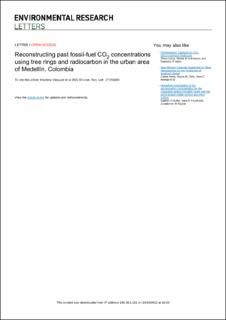| dc.contributor.author | Vásquez, Marileny | |
| dc.contributor.author | Henao, Wilson Lara | |
| dc.contributor.author | del Valle, Jorge I. | |
| dc.contributor.author | Sierra, Carlos A. | |
| dc.date.accessioned | 2022-10-26T07:15:19Z | |
| dc.date.available | 2022-10-26T07:15:19Z | |
| dc.date.created | 2022-09-30T10:17:55Z | |
| dc.date.issued | 2022-04-25 | |
| dc.identifier.citation | Environmental Research Letters. 2022, 17 . | en_US |
| dc.identifier.issn | 1748-9326 | |
| dc.identifier.uri | https://hdl.handle.net/11250/3028300 | |
| dc.description.abstract | To meet international and national commitments to decrease emissions of fossil fuels, cities around the world must obtain information on their historical levels of emissions, identifying hotspots that require special attention. Direct atmospheric measurements of pollution sources are almost impossible to obtain retrospectively. However, tree rings serve as an archive of environmental information for reconstructing the temporal and spatial distribution of fossil-fuel emissions in urban areas. Here, we present a novel methodology to reconstruct the spatial and temporal contribution of fossil-fuel CO2 concentration ([CO2F]) in the urban area of Medellin, Colombia. We used a combination of dendrochronological analyses, radiocarbon measurements, and statistical modeling. We obtained annual maps of [CO2F] from 1977 to 2018 that describe changes in its spatial distribution over time. Our method was successful at identifying hotspots of emissions around industrial areas, and areas with high traffic density. It also identified temporal trends that may be related to socioeconomic and technological factors. We observed an important increase in [CO2F] during the last decade, which suggests that efforts of city officials to reduce traffic and emissions did not have a significant impact on the contribution of fossil fuels to local air. The method presented here could be of significant value for city planners and environmental officials from other urban areas around the world. It allows identifying hotspots of fossil fuels emissions, evaluating the impact of previous environmental policies, and planning new interventions to reduce emissions. | en_US |
| dc.description.abstract | Reconstructing past fossil-fuel CO2 concentrations using tree rings and radiocarbon in the urban area of Medellín, Colombia | en_US |
| dc.language.iso | eng | en_US |
| dc.publisher | IOP Science | en_US |
| dc.rights | Navngivelse 4.0 Internasjonal | * |
| dc.rights.uri | http://creativecommons.org/licenses/by/4.0/deed.no | * |
| dc.title | Reconstructing past fossil-fuel CO2 concentrations using tree rings and radiocarbon in the urban area of Medellín, Colombia | en_US |
| dc.title.alternative | Reconstructing past fossil-fuel CO2 concentrations using tree rings and radiocarbon in the urban area of Medellín, Colombia | en_US |
| dc.type | Peer reviewed | en_US |
| dc.type | Journal article | en_US |
| dc.description.version | publishedVersion | en_US |
| dc.rights.holder | © 2022 The Author(s) | en_US |
| dc.source.pagenumber | 11 | en_US |
| dc.source.volume | 17 | en_US |
| dc.source.journal | Environmental Research Letters | en_US |
| dc.identifier.doi | 10.1088/1748-9326/ac63d4 | |
| dc.identifier.cristin | 2057054 | |
| dc.source.articlenumber | 055008 | en_US |
| cristin.ispublished | true | |
| cristin.fulltext | original | |
| cristin.qualitycode | 2 | |

